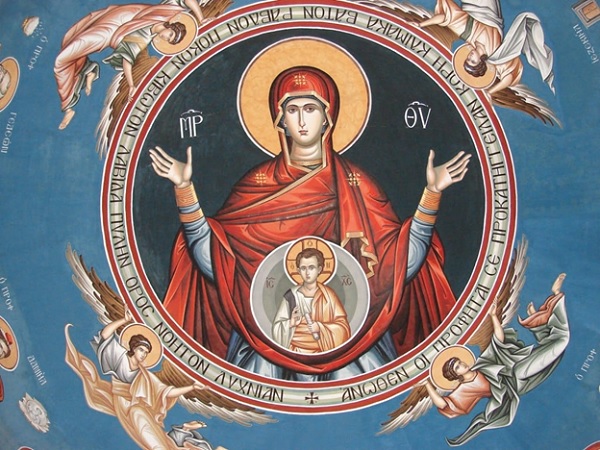The Akathistos Hymn
3 April 2023In official liturgical language, this service is known as the ‘Akathistos Hymn’, or simply ‘Akathistos’ (= ‘Not seated’) from the fact that the faithful remained standing throughout the singing. The words and the attitude of the body were thus expressions of honor, particular devotion and gratitude to her to whom the salutations are addressed.
In today’s liturgical practice, this service is incorporated into the framework of small compline. It’s celebrated, in parts, every Friday for the first four weeks of the fast, and then sung in full on the Friday of fifth week. In monasteries, as well as in parish practice today and in the past, depending on their typiko, we also have other contexts for the singing of the hymn: the mattins service, vespers, the vigil, or a service to the Mother of God celebrated only in Constantinople called ‘the prayer’. In all these cases, at a specified point in the normal service, there’s an interpolation and the canon of the Mother of God is sung, together with the kontakio and the salutations of the Akathistos.

We shall not dwell on the thorny issue of the time of its composition nor the poet who wrote the Akathistos. Many authors have been proposed: Romanos the Melodist, Georgios Pisidis, Patriarchs Sergios and Germanos 1 of Constantinople, Saint Fotios, and Georgios of Nicomedia, poets who lived between the 7th and 9th centuries. The tradition is very shaky here and, going by what little internal evidence there is in the texts, modern scholars are divided on the issue of authorship, some preferring one possible writer and others another. A historical event which has traditionally been linked to the singing of the Akathistos may assist us in refining our search: the siege of Constantinople at the time of Emperor Irakleios (Heraclius) and the miraculous deliverance of the city on August 8, in the year 626. According to the Synaxari, once the siege was lifted, this hymn was sung in the church of the Mother of God at Vlahernai (Blachernae) as praise and thanks for the deliverance, which was attributed to the miraculous power of the Mother of God, the protectress of the City*. The Patriarch at the time was Sergios, who was in charge of the efforts for the defence of the capital. It is easy to suppose that he was the composer of the hymn, but he’s not known to us as a hymn-writer, nor was he even Orthodox. Besides, the hymn must be older because if it were written about the deliverance of the city, it would not have been possible to refer specifically to this without mentioning other issues, as we shall see below. The singing of the Akathistos is also associated by historical sources with other, similar events: the sieges and deliverance of the city during the reigns of Konstantinos Pogonatos (673), Leo the Isaurian (717-718) and Michael III (860).
Whoever the poet may have been and whatever historical event it may initially have been linked to, there’s one fact provided by the relevant sources which is beyond doubt: the hymn was sung as an ode of gratitude to the commander and defender of the Byzantine state at the vigils of thanksgiving which were held in commemoration of the above events. According to the observation in the Synaxari, the hymn is called Akathistos because at the time of the deliverance of the City and up till today, when the canticles of the hymn were being sung, everyone stood to hear them as a sign of gratitude to the Mother of God, whereas at the canticles of other kontakia, the custom was to sit.
But why is it sung in Great Lent? The above sieges were raised at other times of the year. The siege of Irakleios ended on 8 August; that of Pogonatos in September; the commemoration of the deliverance of the City under Leo the Isaurian is celebrated on 16 August; and the siege under Michael III was raised on 18 July.
It was probably linked to Great Lent for another, purely liturgical reason: that the great feast of the Annunciation of the Mother of God always falls within the fast. Because of the mournful nature of Lent, this feast is deprived of pre- and post-festal hymns. It’s precisely this lack that is covered by singing the Akathistos, in parts at compline on Fridays and in full at mattins on Saturday in fifth week. Liturgically, Friday evening belongs to Saturday, a day which, together with Sunday, are the only ones in Lent on which joyful events may be celebrated. Any feasts which fall on weekdays are transferred to these days. In certain typika, the Akathistos was sung five days before the feast of the Annunciation; according to others, at mattins on the morning of the feast. The Akathistos is the kontakio of the Annunciation, the hymn of the incarnation of the Word of God.
As we’ve mentioned, when the Akathistos was associated with historical events, a new, special proem was added, full of praise and supplication, the well-known hymn ‘To you Mother of God’: ‘To you, Mother of God, our commander and defender, your city, delivered from calamity, offers hymns of victory and thanksgiving. But since you have unassailable might, set us free from every peril that we may cry to you: ‘Hail Bride unwedded’.






